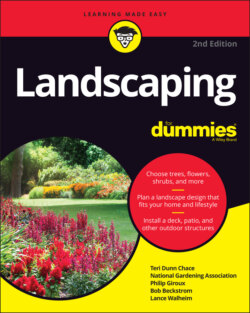Читать книгу Landscaping For Dummies - Lance Walheim - Страница 62
Filling in the rest
ОглавлениеNow you get to make all sorts of messes. Well, your yard may look that way to somebody else. To you, it’s a vision taking shape. Do the following when adding the remaining items:
Outline curving paths with hose or rope, or sprinkle a path of oatmeal, flour, or white play sand (this last option is sold in bags and has the advantage of not dissolving if it rains), so that you can see the direction it takes. No need to use a lot by making a solid line — a dotted line works.
Pound in stakes or use buckets to show the future homes of rosebushes or large perennials in your flowerbeds.
Rake the leaves, grass clippings, or straw and fill in the outlines so you can easily get a feel for your new beds.
Visualize a fence, long planter box, terraces, or raised beds by putting in stakes at the projected height and running string between them.
By this time your property will no doubt be ringed with throngs of curious neighbors who will be sure that this time you’ve totally lost your mind. Fill them in, if you feel inclined, or let them wonder as you walk around your new landscape.
Squint your eyes, throw your imagination into full gear, and check the position of the elements you’ve placed from every vantage point you can think of. Remember, that’s not a plastic chair: It’s a graceful evergreen. Five-gallon bucket? No, a beautiful flowering shrub.
Shift around any of the parts of your portable garden until you like the way it looks. When you have this part of your yard arranged to your satisfaction, mark your rough plan with revised lines to show bed edges, plant placement, and any other niceties that you want to note. Then move on to the next section of your yard and do it again. Repeat until your landscape plan is finished.
